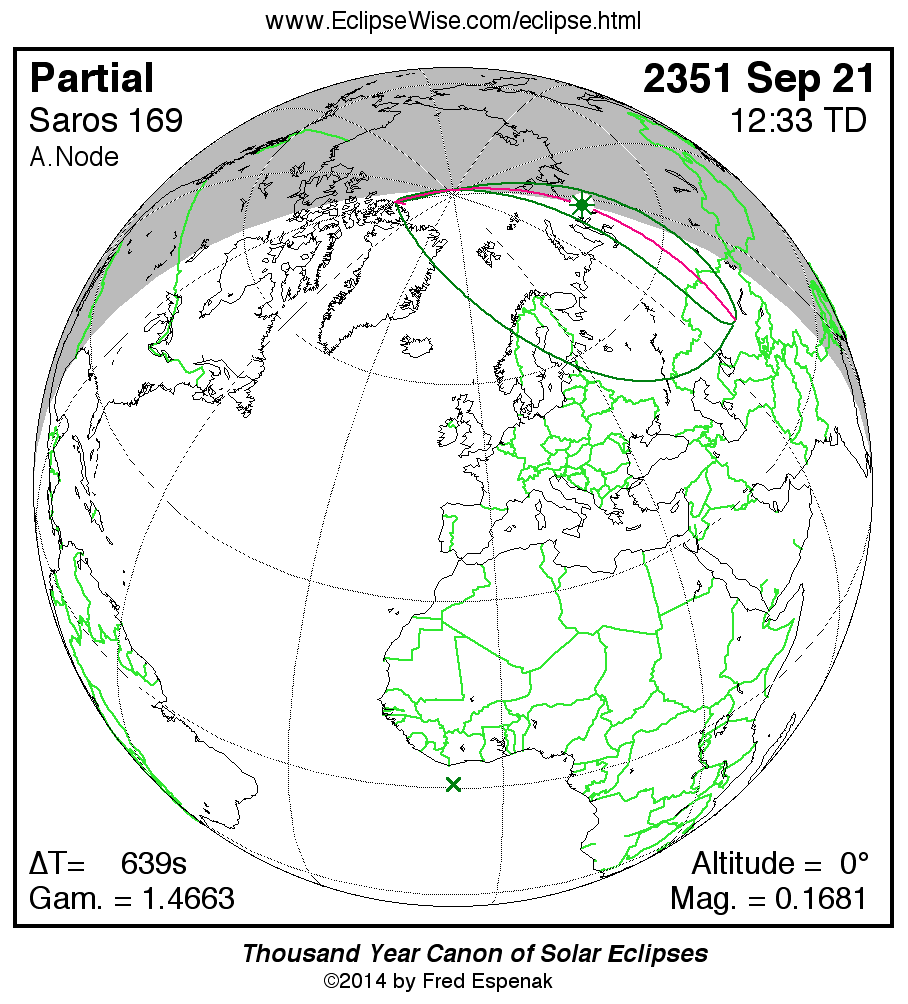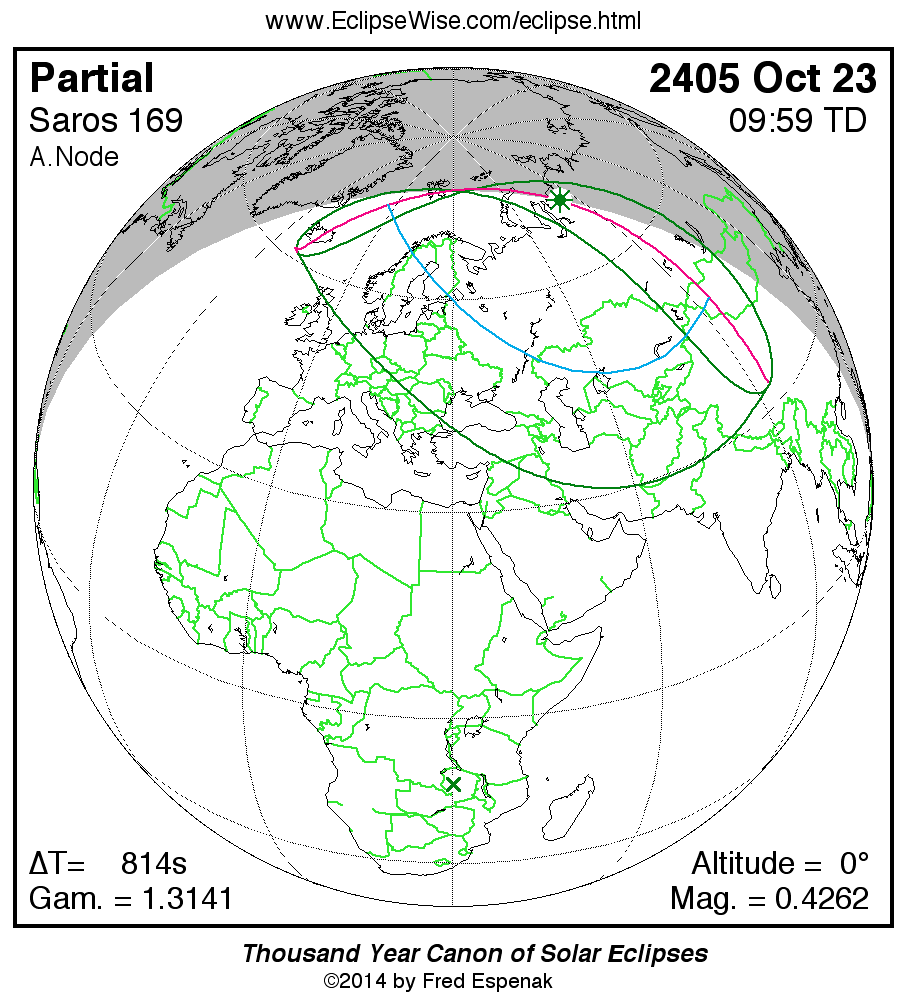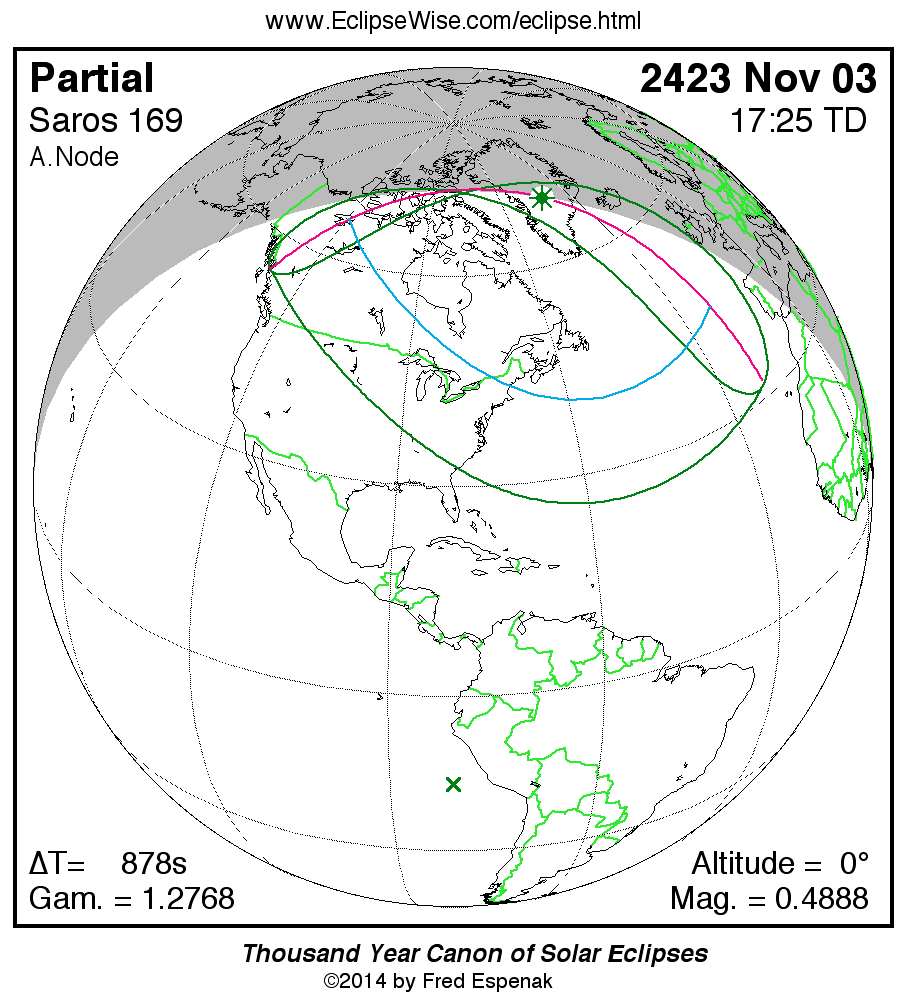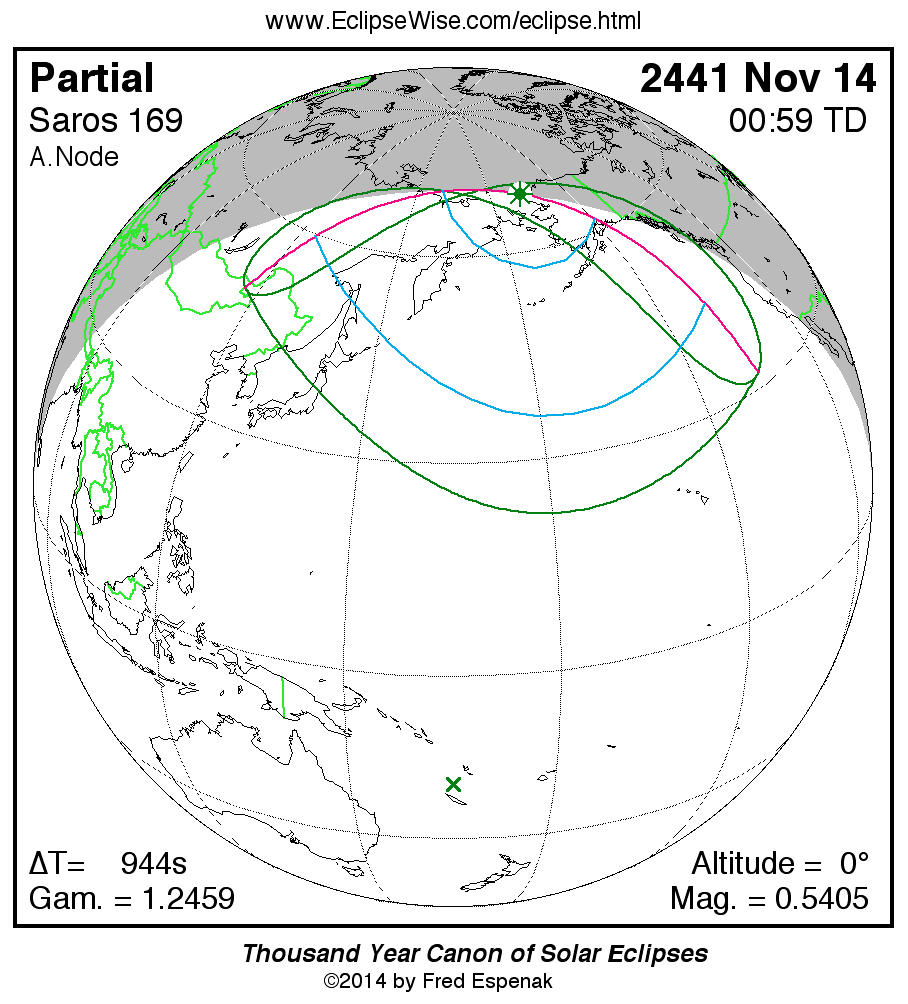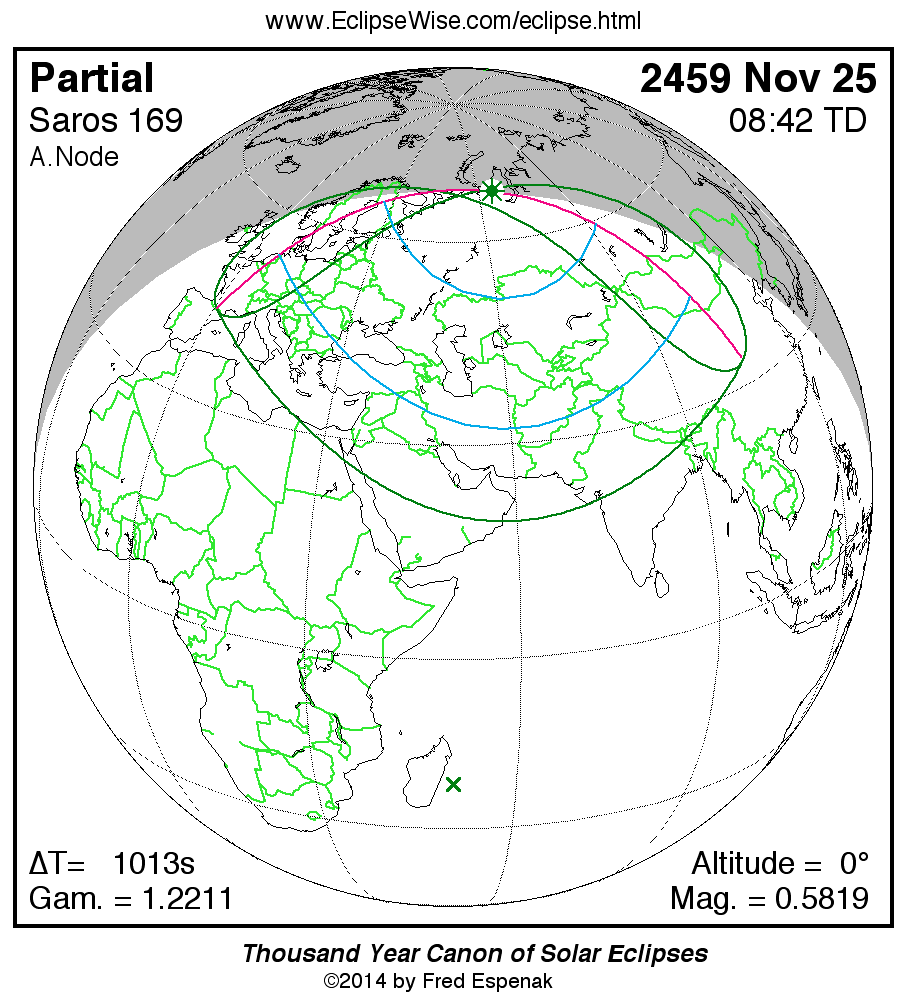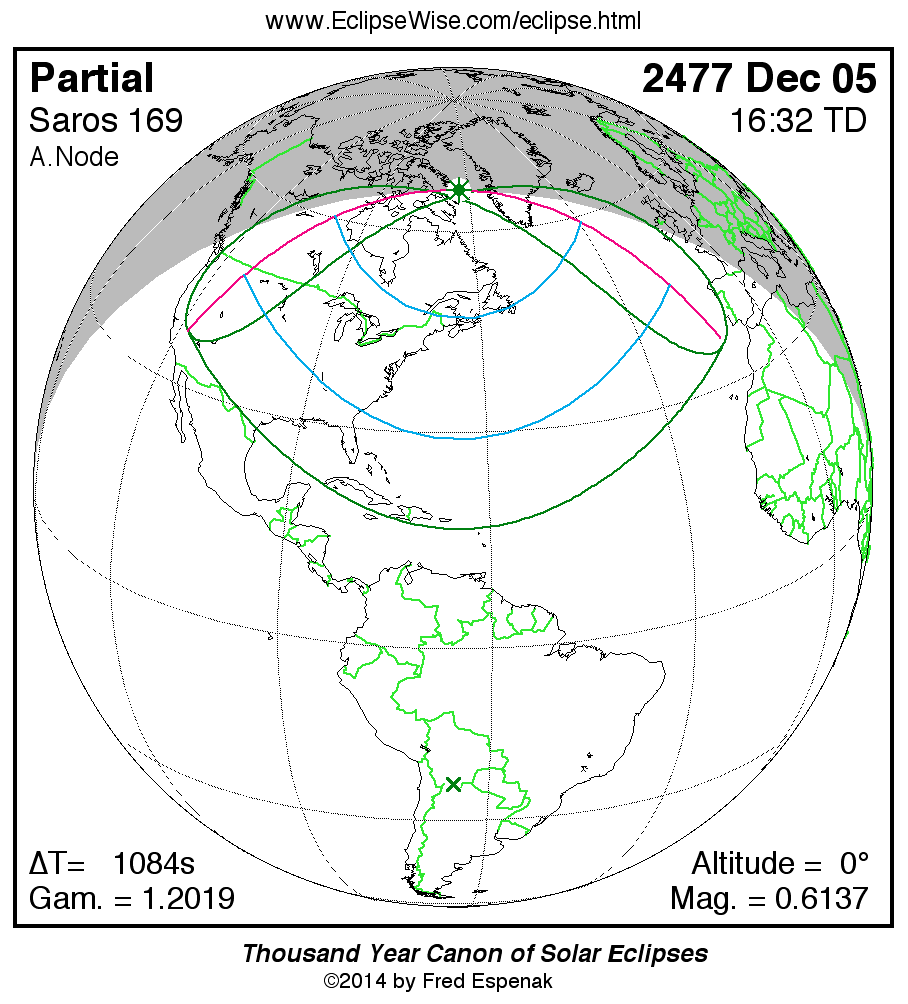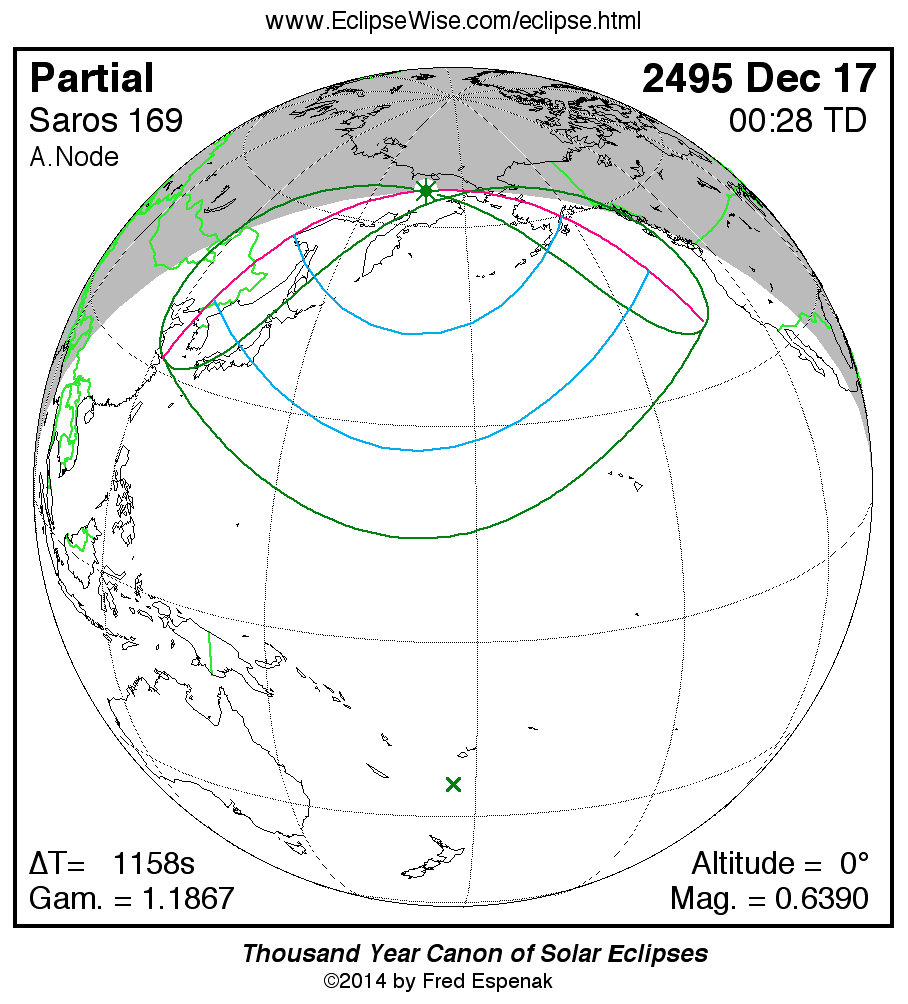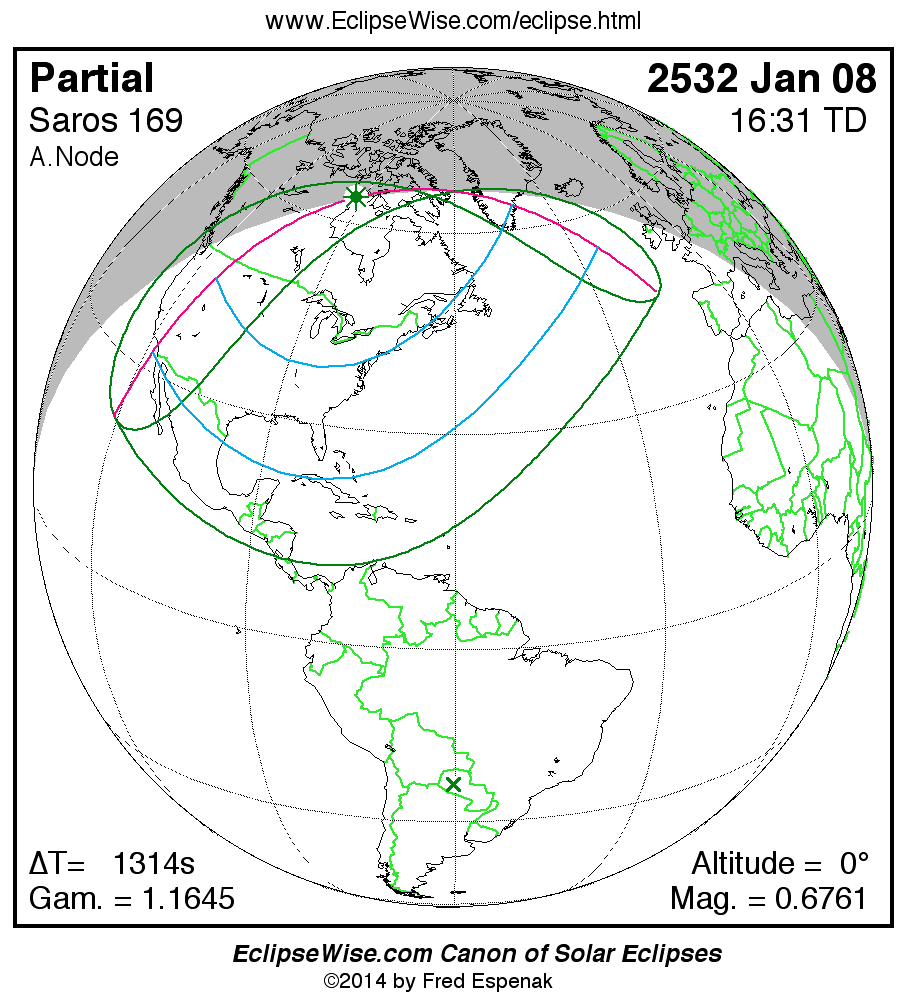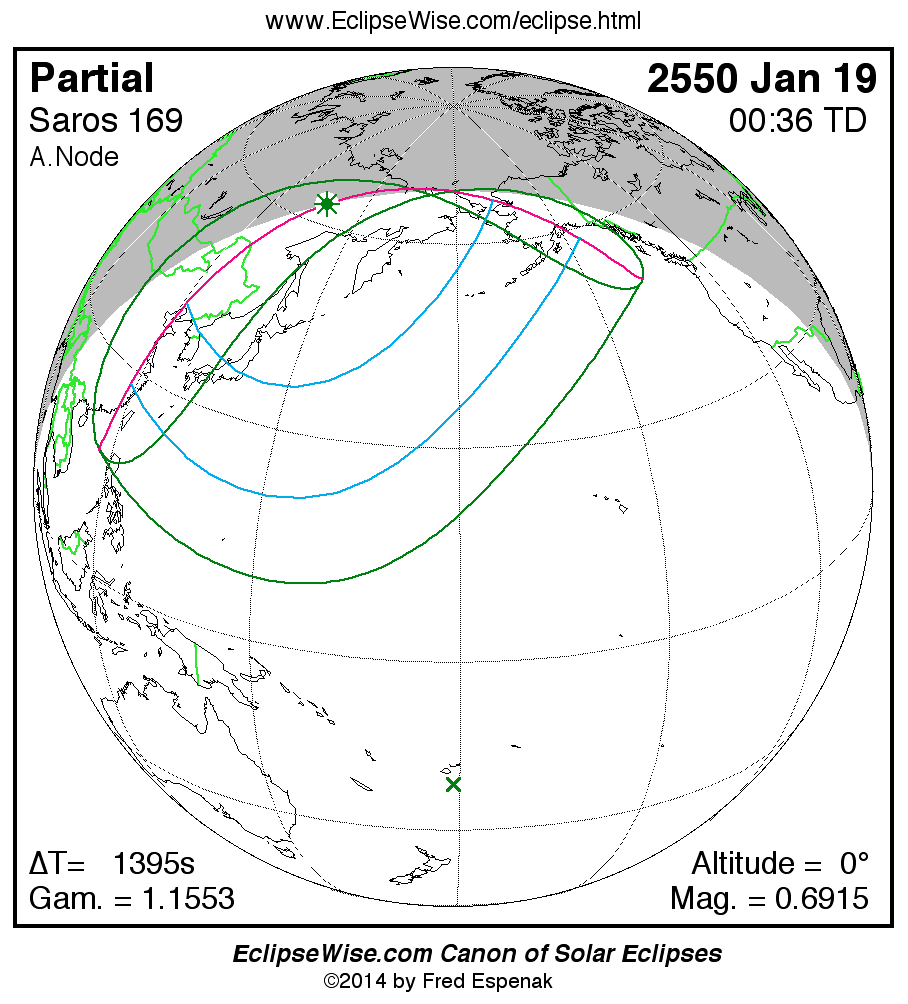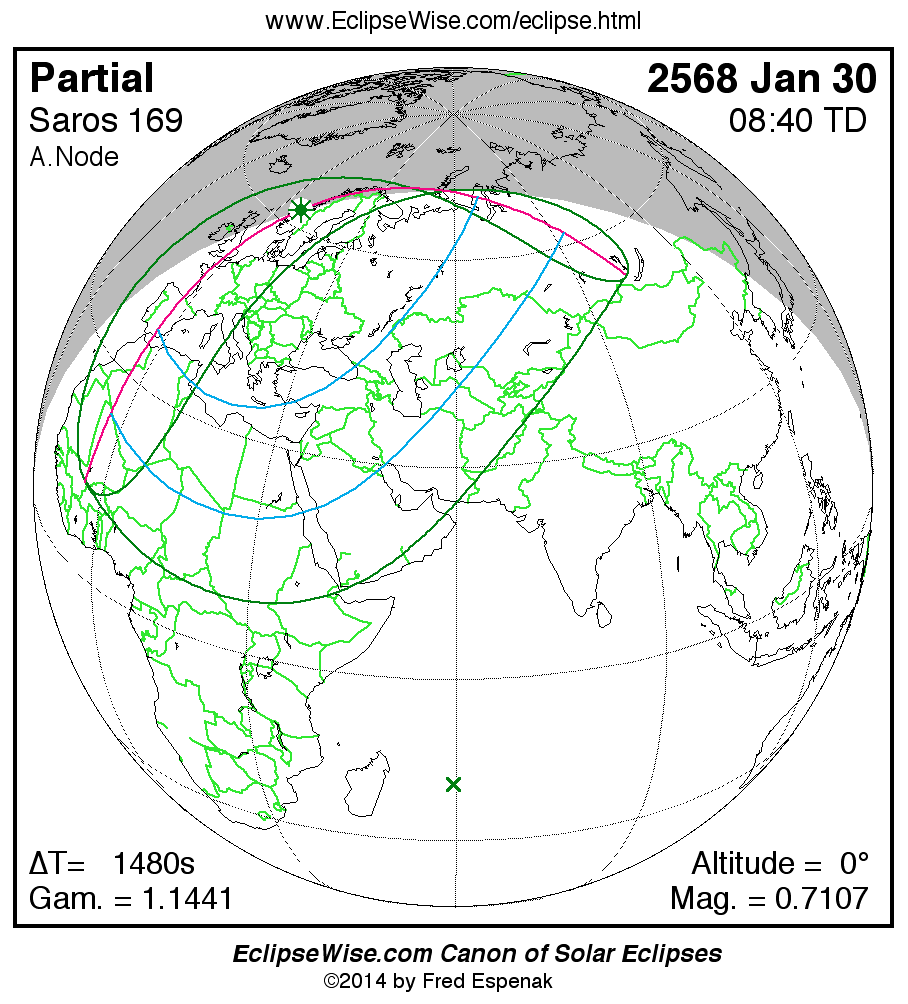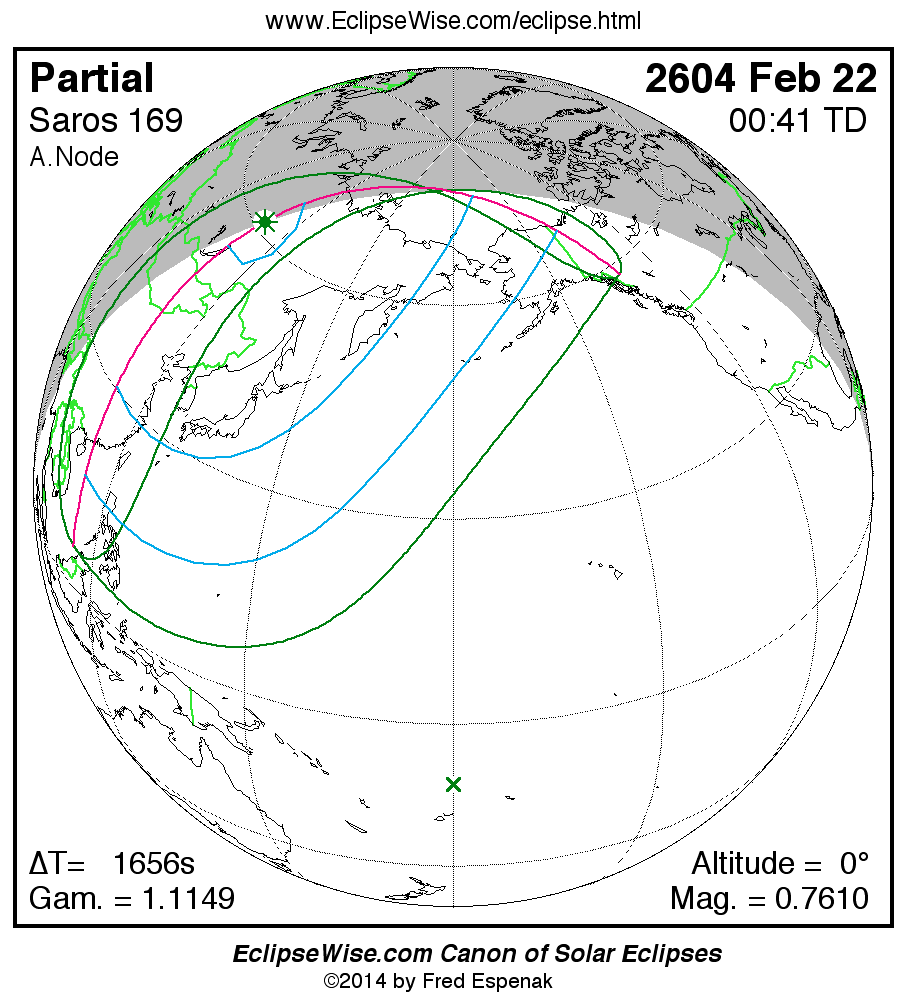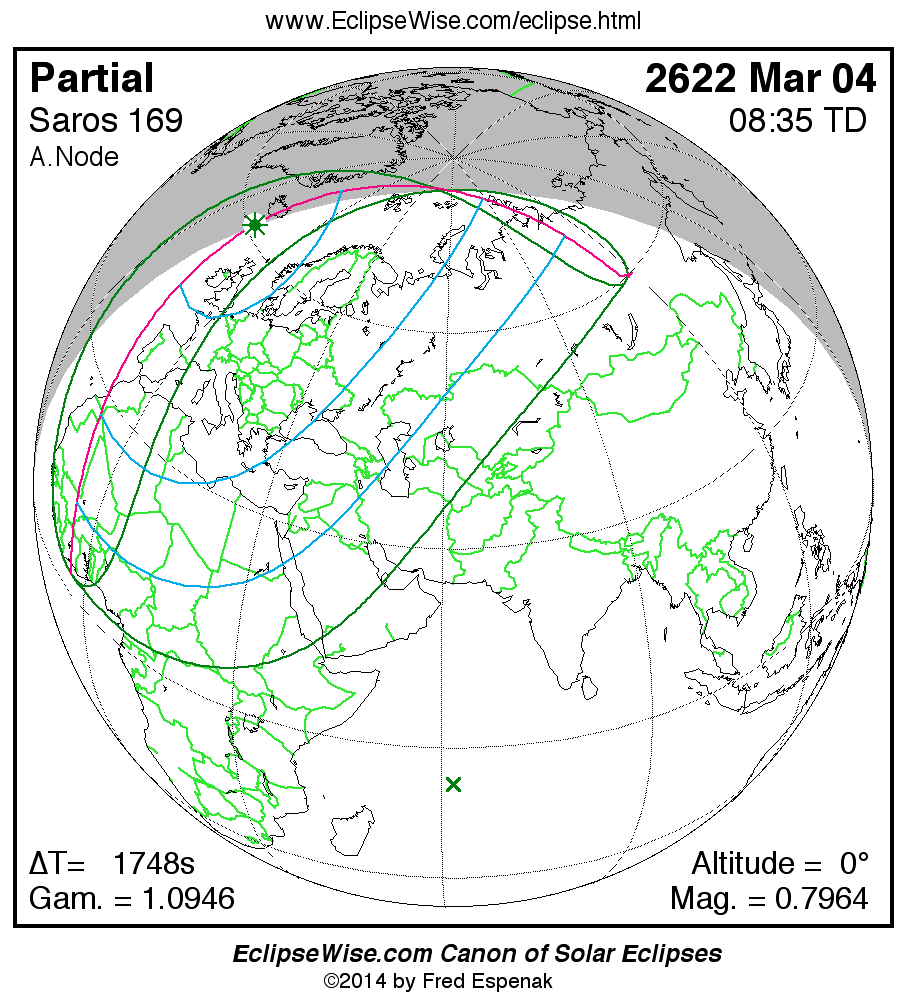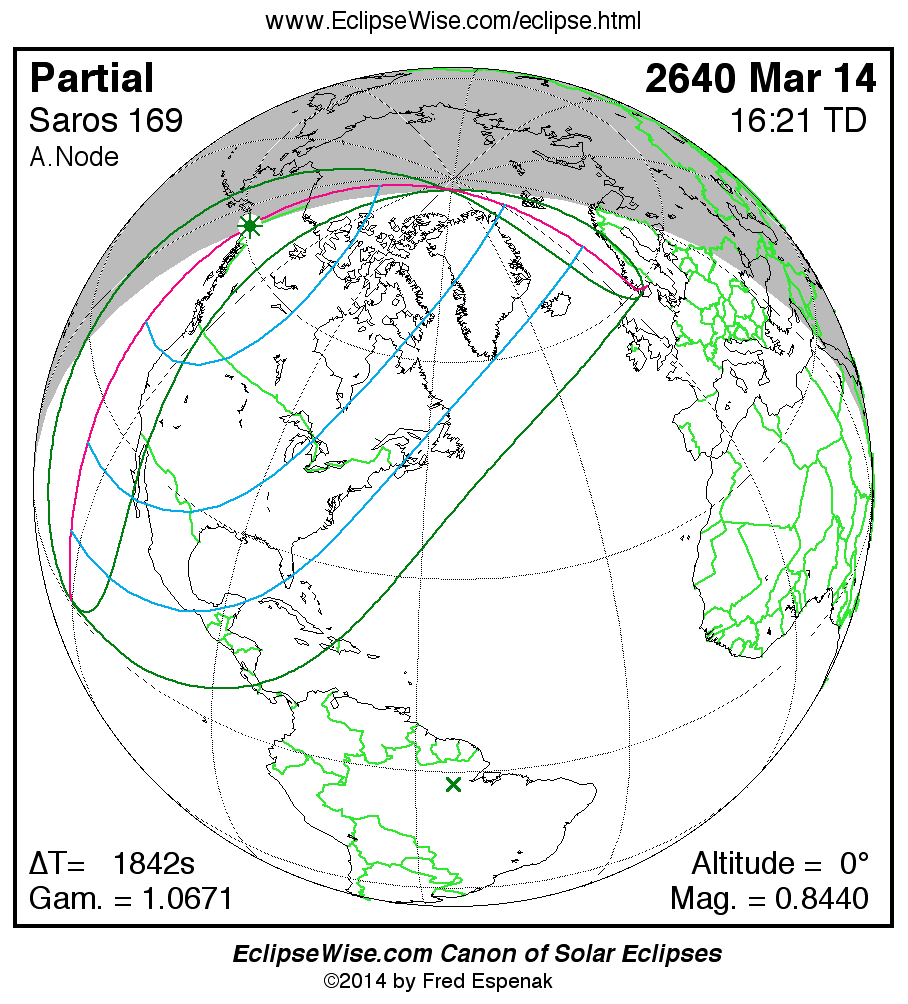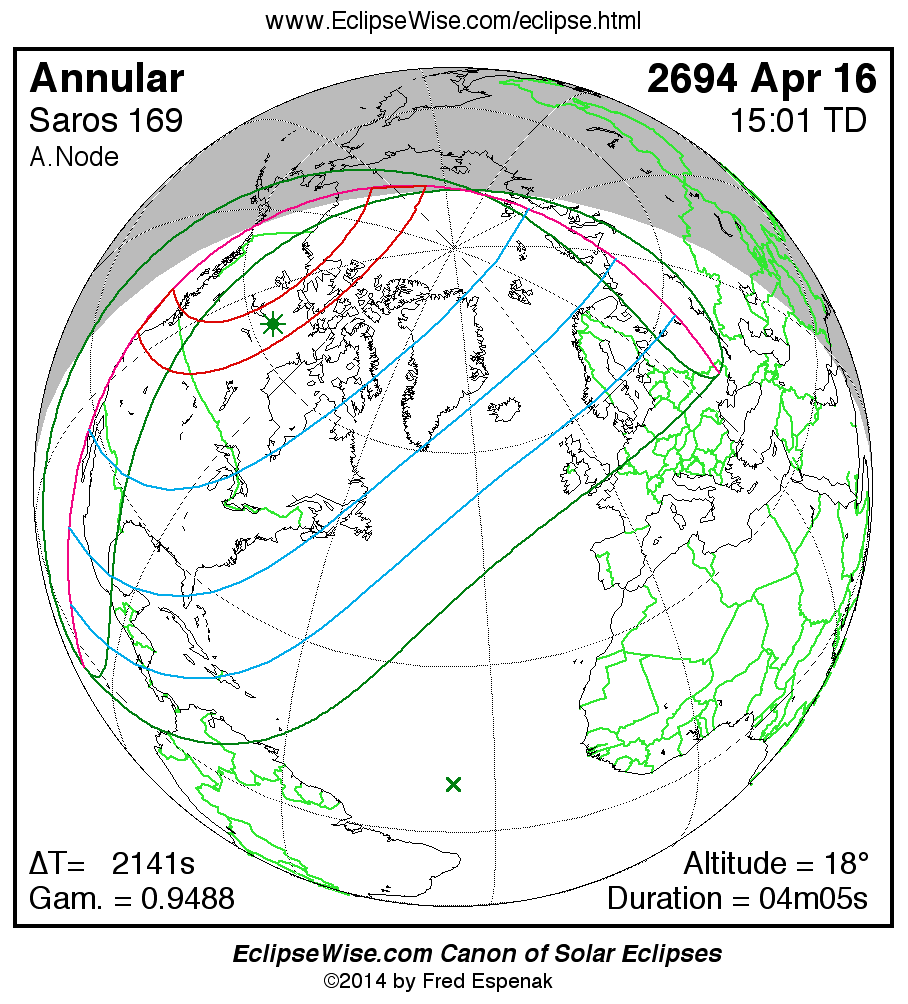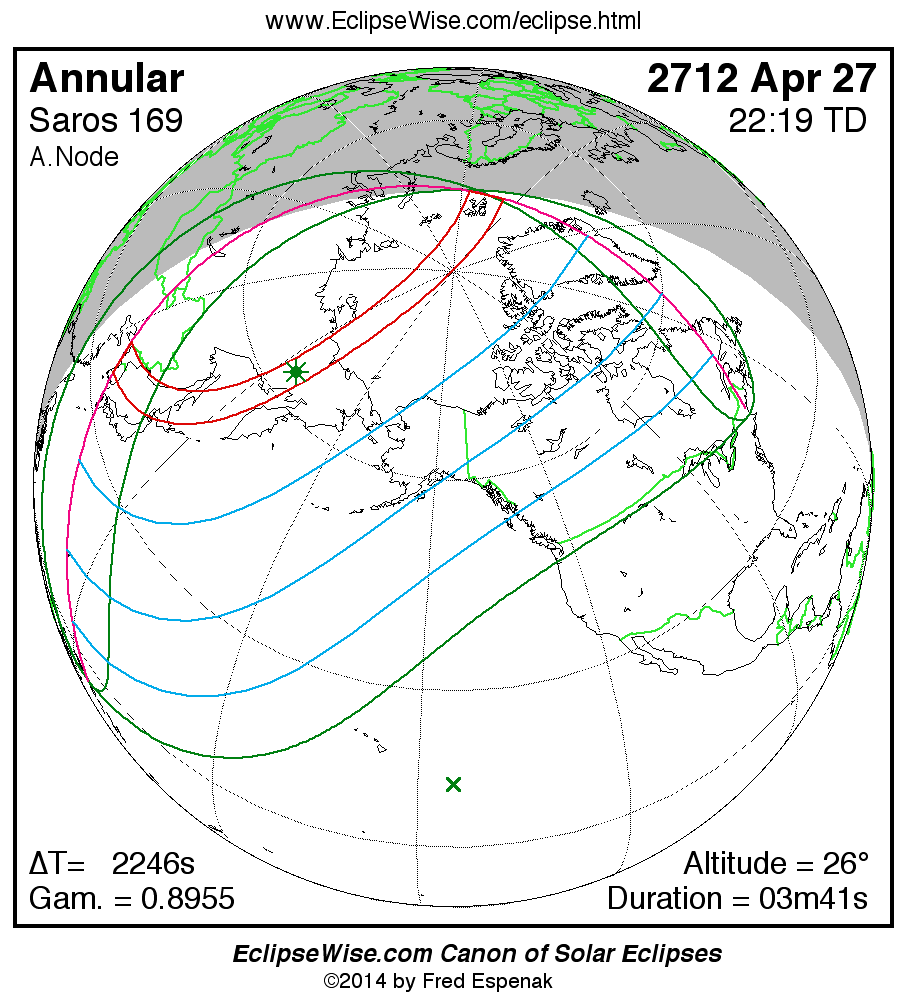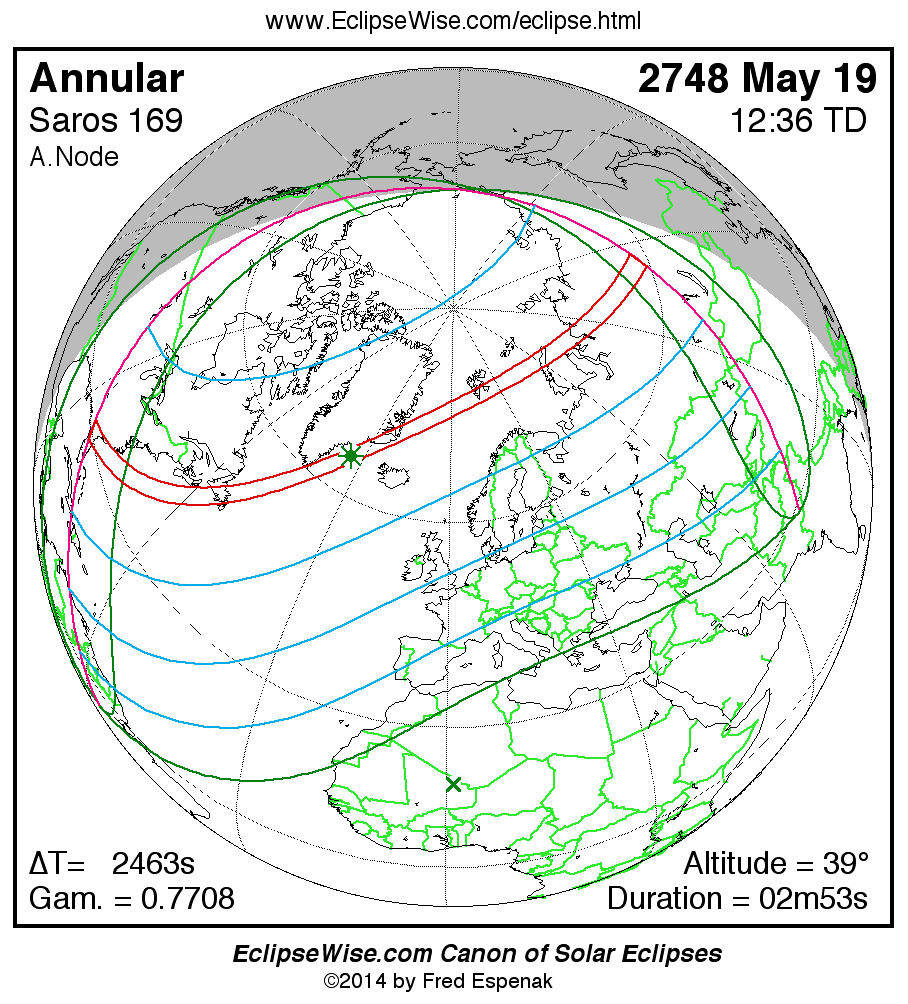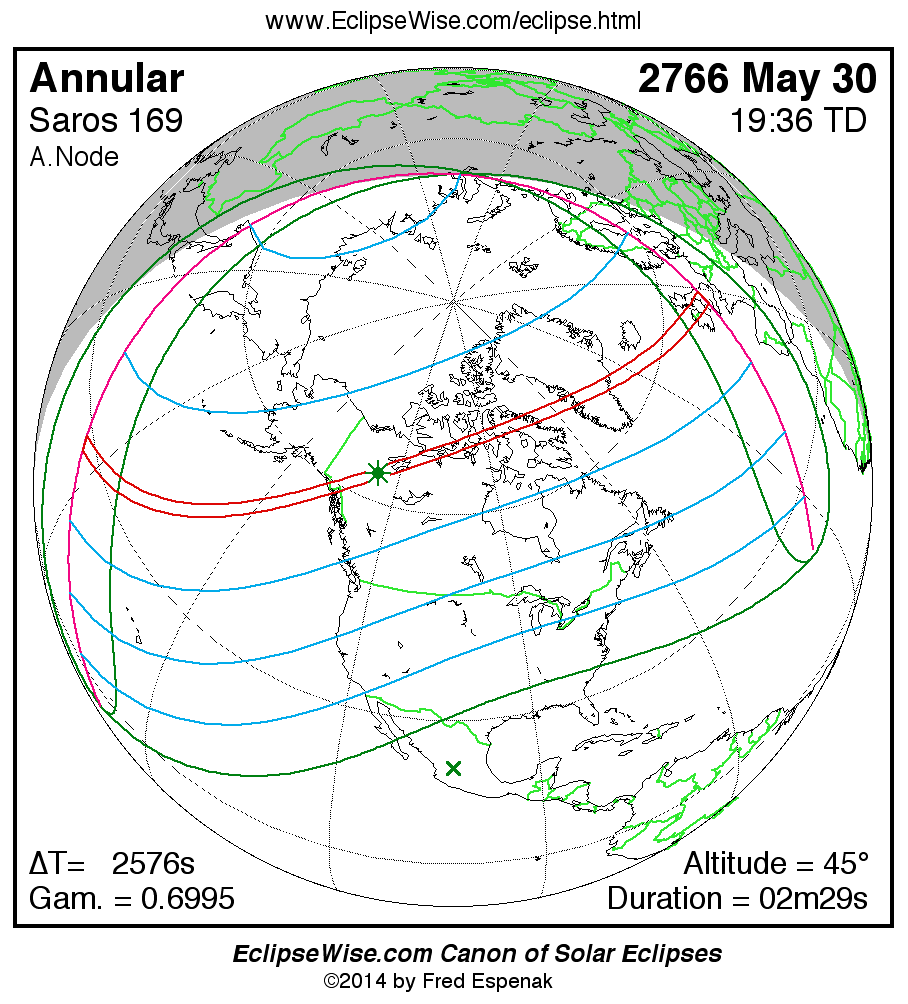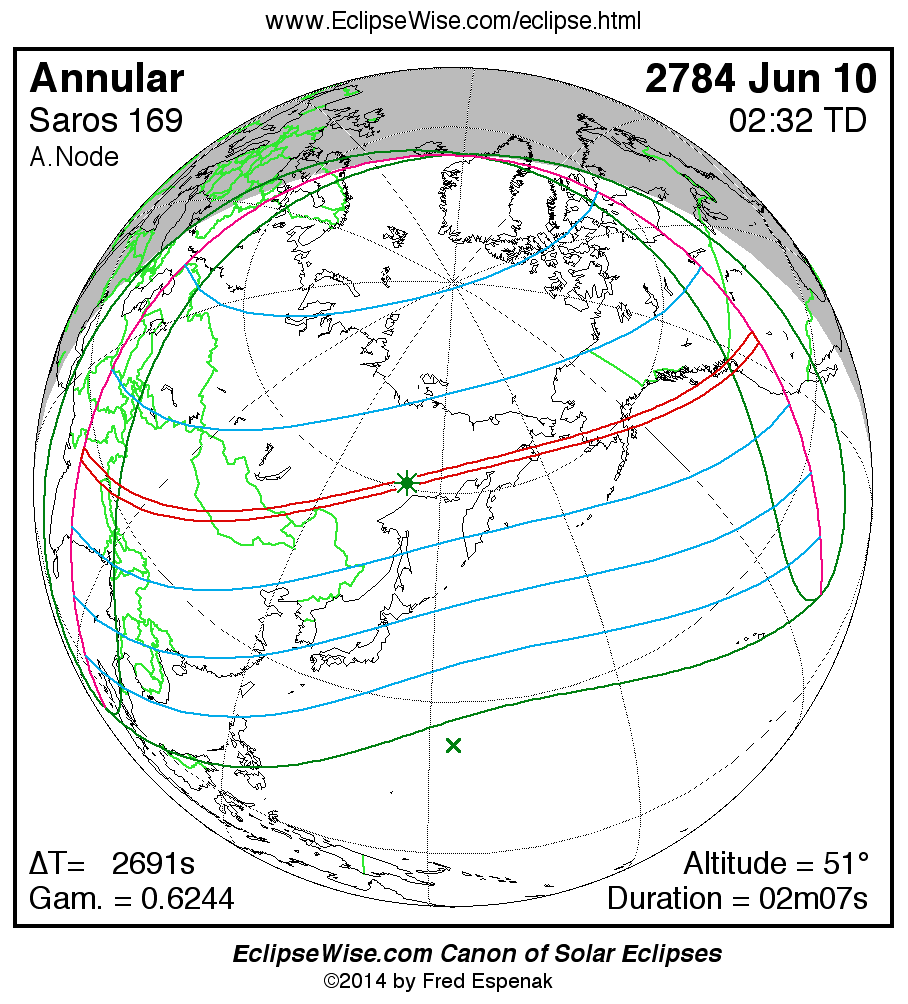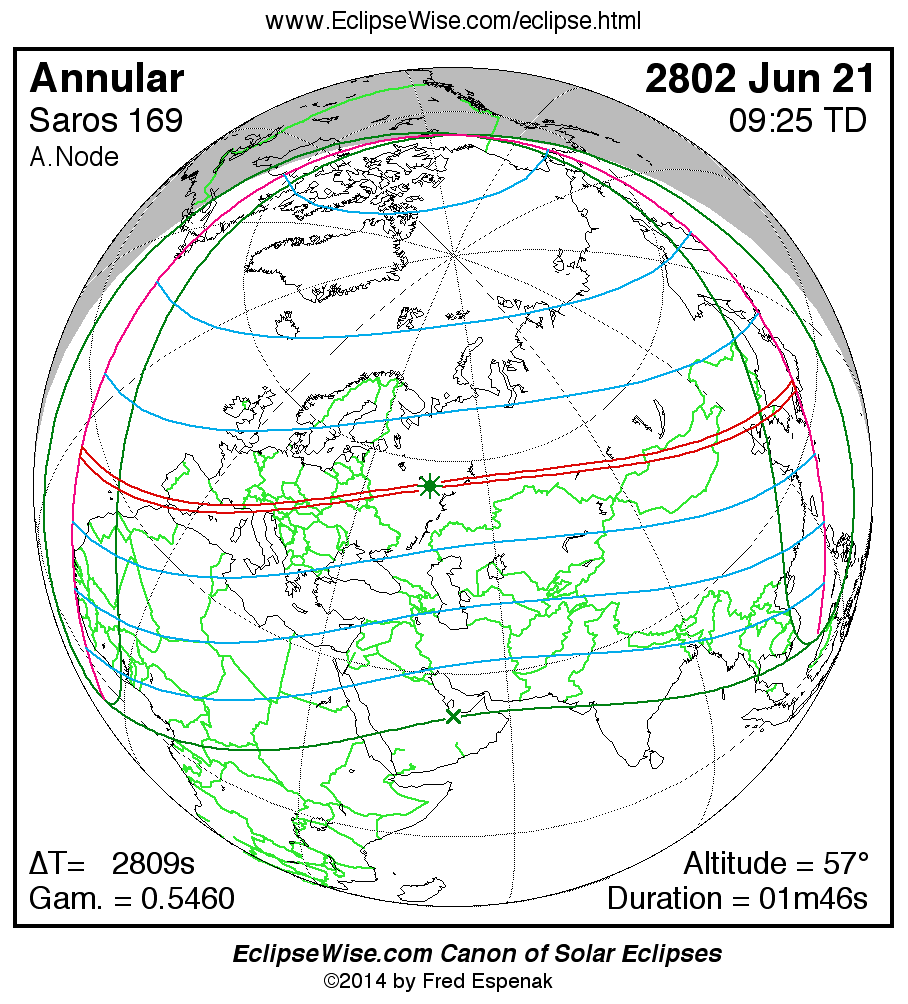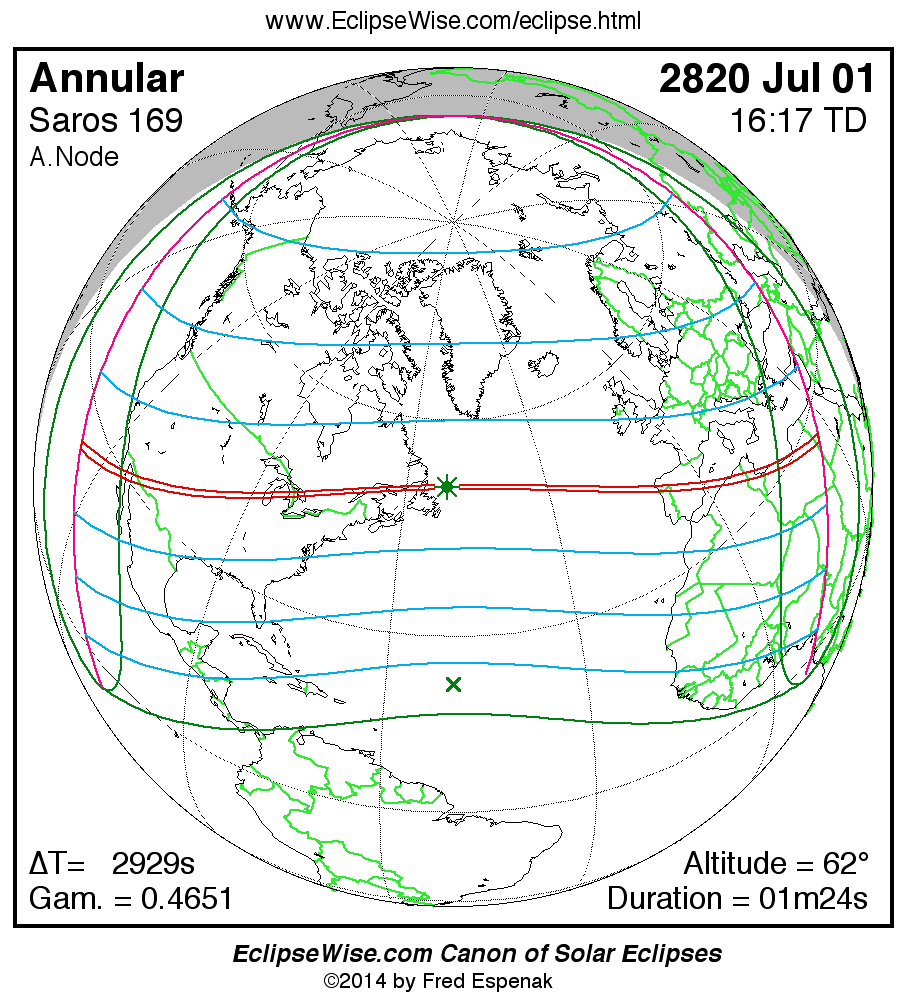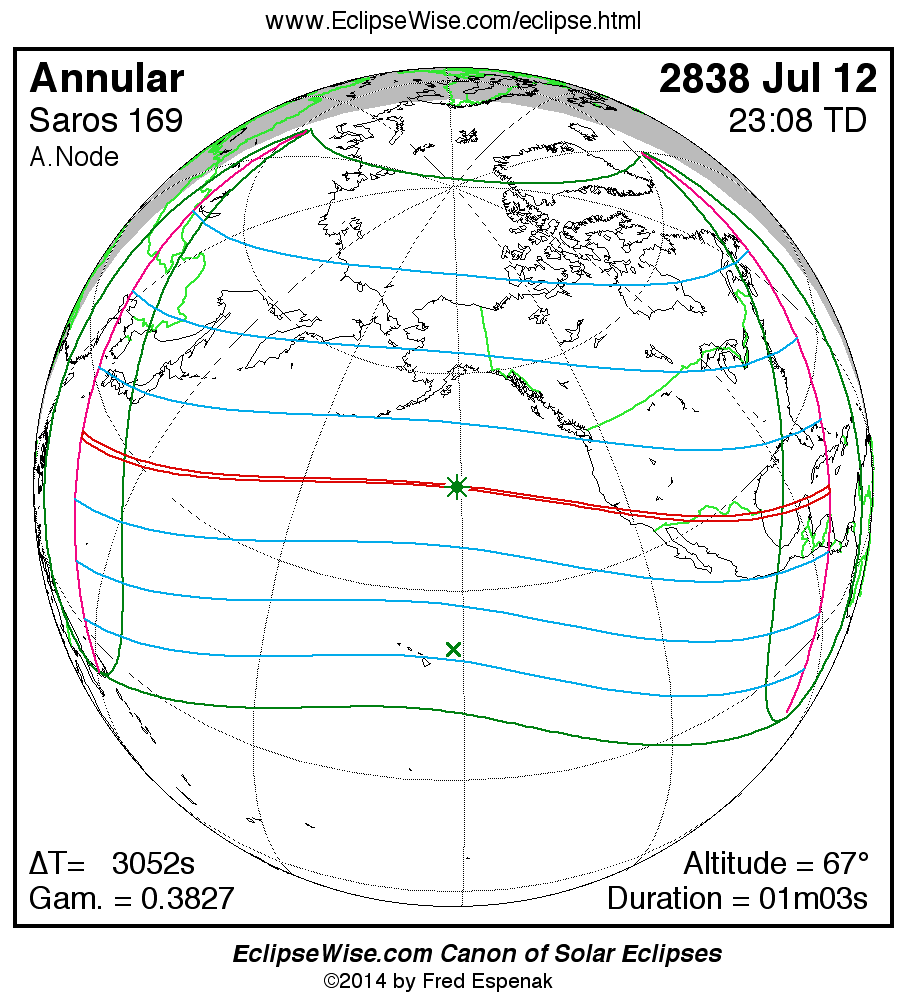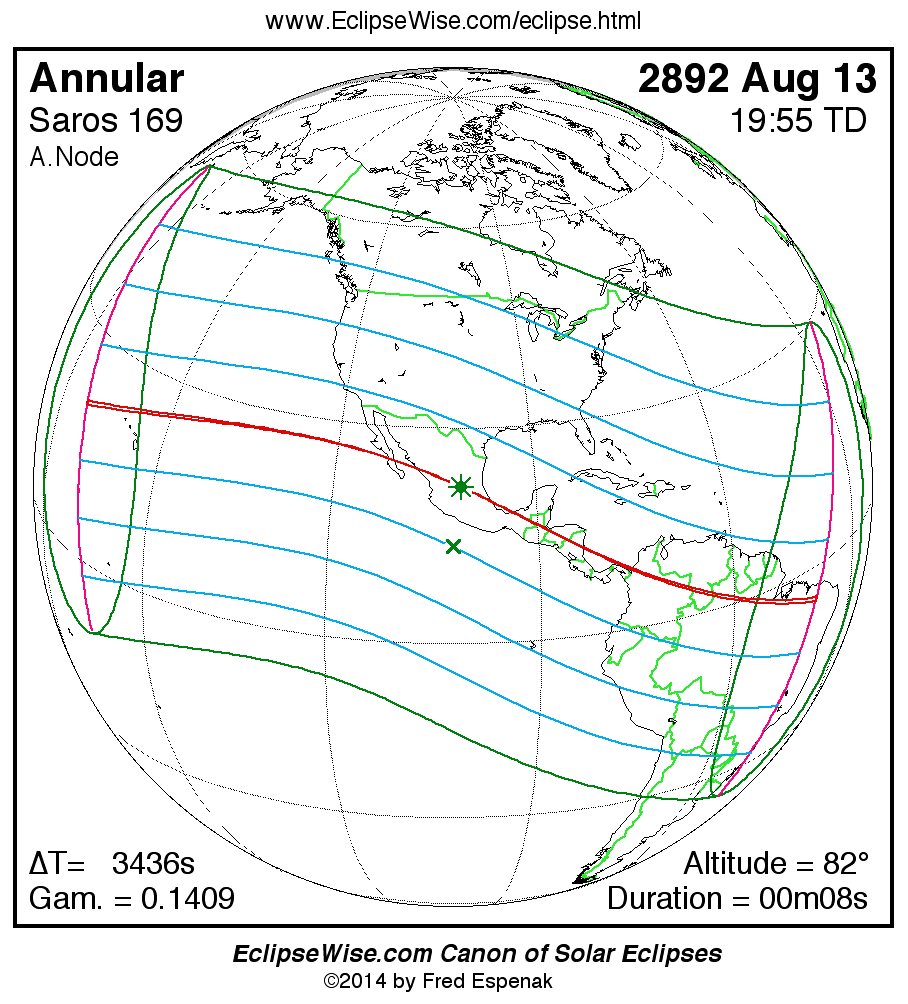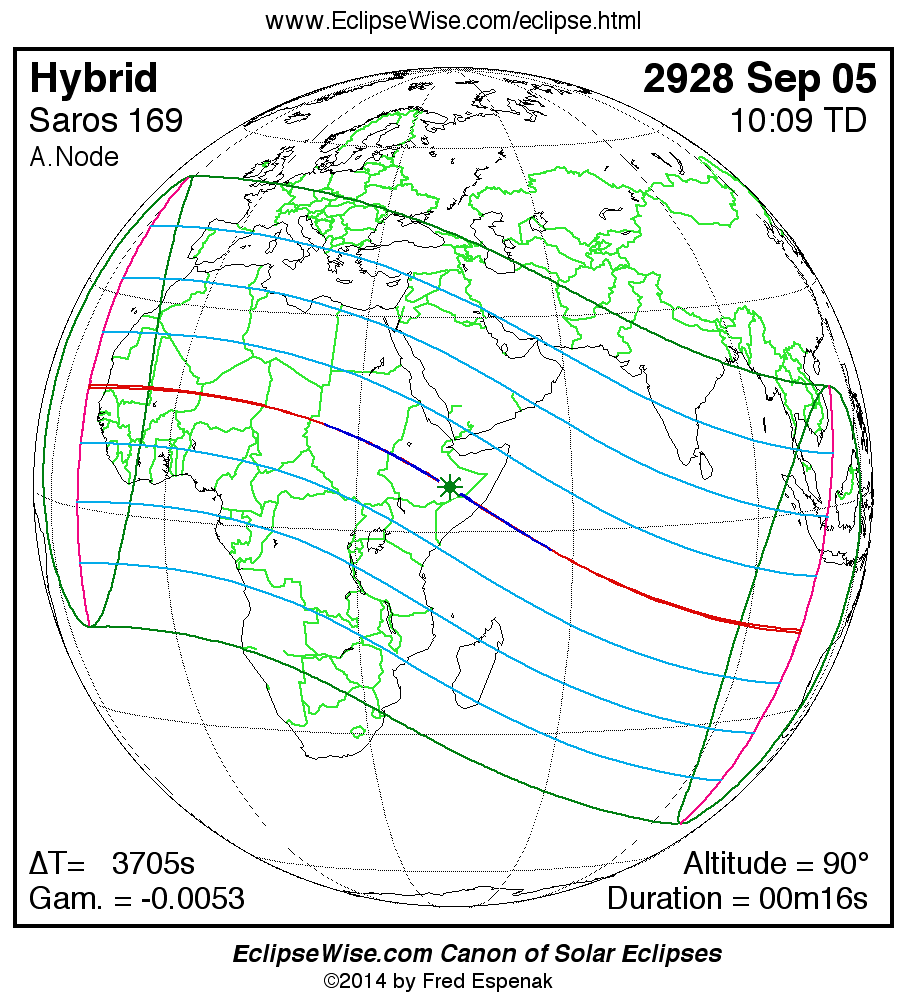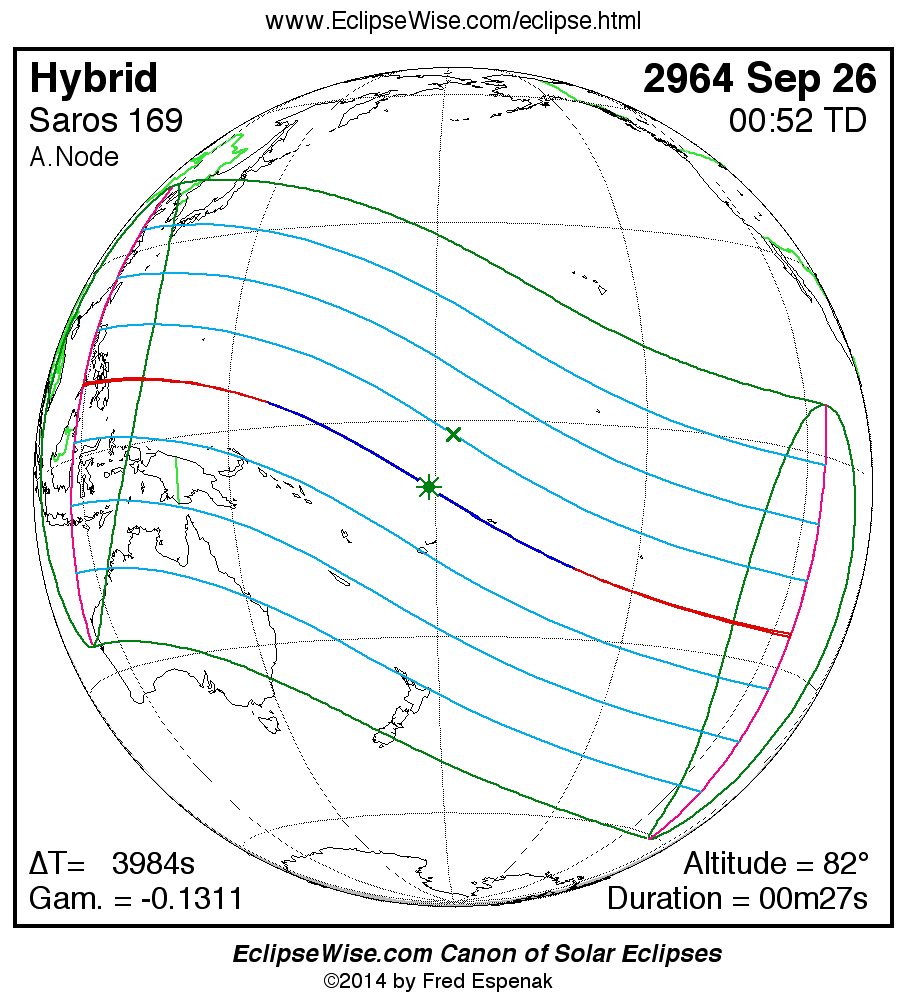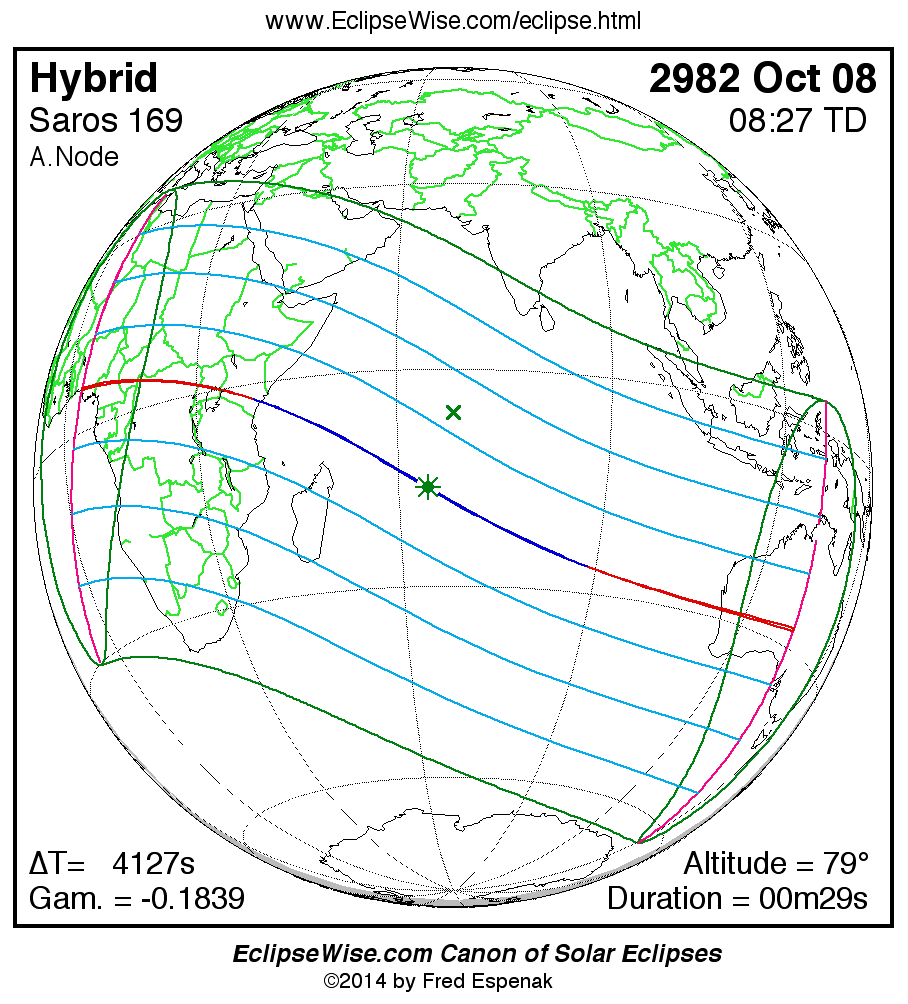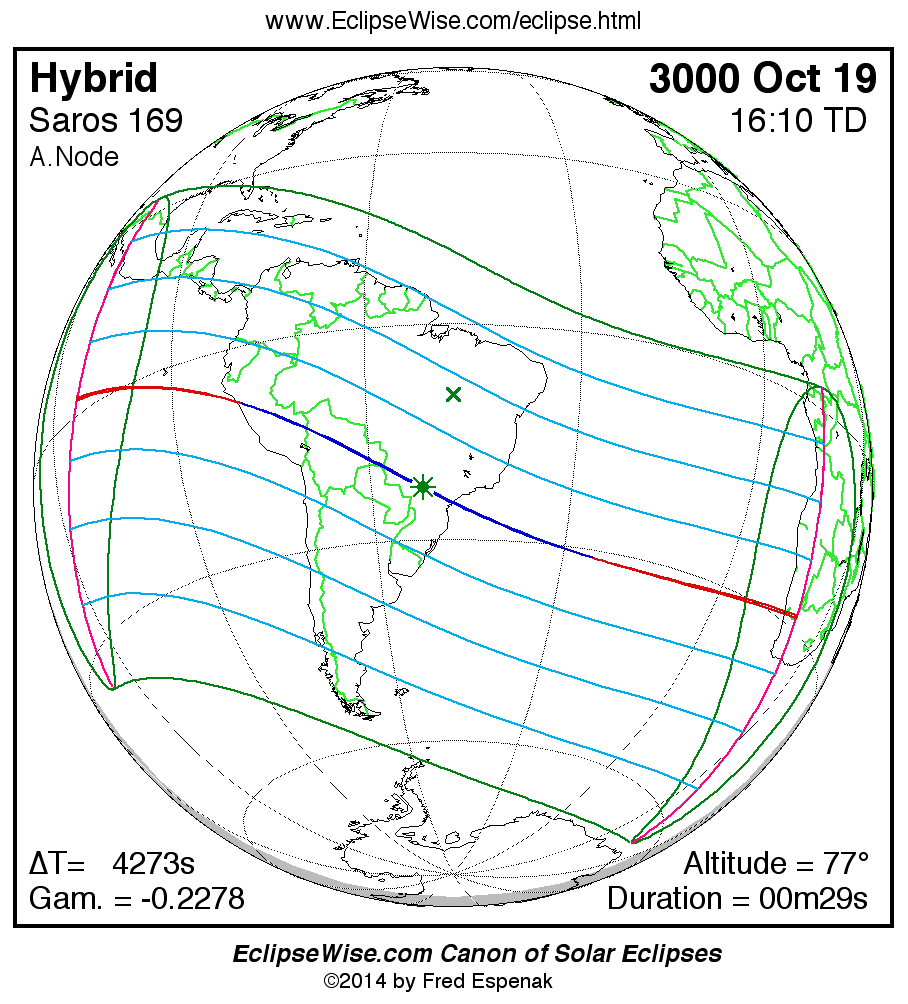Saros 169
Panorama of Solar Eclipses of Saros 169
Fred Espenak
Introduction
A solar eclipse occurs whenever the Moon's shadow passes across Earth's surface. At least two solar eclipses and as many as five occur every year.
The periodicity and recurrence of solar eclipses is governed by the Saros cycle, a period of approximately 6,585.3 days (18 years 11 days 8 hours). When two eclipses are separated by a period of one Saros, they share a very similar geometry. The two eclipses occur at the same node with the Moon at nearly the same distance from Earth and the same time of year due to a harmonic in three cycles of the Moon's orbit. Thus, the Saros is useful for organizing eclipses into families or series. Each series typically lasts 12 to 13 centuries and contains 70 or more eclipses. Every saros series begins with a number of partial eclipses near one of Earth's polar regions. The series will then produce several dozen central eclipses before ending with a group of partial eclipses near the opposite pole. For more information, see Periodicity of Solar Eclipses.
Panorama of Solar Eclipses of Saros 169
A panorama of all solar eclipses belonging to Saros 169 is presented here. Each map depicts the geographic region of visibility for a single eclipse. For central eclipses, the total or annular path is plotted in either blue (total) or red (annular). The date and time is given for the instant of Greatest Eclipse. Every map serves as a hyperlink to the EclipseWise Prime page for that eclipse where a larger map and complete details for the eclipse can be found. Visit the Key to Solar Eclipse Maps for a detailed explanation of these maps. Near the bottom of the page are a series of hyperlinks for more on solar eclipses.
The exeligmos is a period of three Saros cycles and is equal to approximately 54 years 33 days. Because it is nearly an integral number of days in length, two eclipses separated by 1 exeligmos (= 3 Saroses) not only share all the characterists of a Saros, but also take place in approximately the same geographic location.
The Saros panorama below is arranged in horizontal rows of 3 eclipses. So one eclipse to the left or right is a difference of 1 Saros cycle, and one eclipse above or below is a difference of 1 exeligmos. By scanning a column of the table, it reveals how the geographic visibility of eclipses separated by an exeligmos slowly changes.
- Click on any global map to go directly to the EclipseWise Prime Page for more information, tables, diagrams and maps. Key to Solar Eclipse Maps explains the features in these maps.
- Beneath each global eclipse map is a link Google Eclipse Map, that takes you to an interactive Google Map with the eclipse path plotted.
For more information on this series see Statistics for Solar Eclipses of Saros 169 .
Statistics for Solar Eclipses of Saros 169
Solar eclipses of Saros 169 all occur at the Moon’s ascending node and the Moon moves southward with each eclipse. The series will begin with a partial eclipse in the northern hemisphere on 2333 Sep 10. The series will end with a partial eclipse in the southern hemisphere on 3595 Oct 16. The total duration of Saros series 169 is 1262.11 years.
| Summary of Saros 169 | |
| First Eclipse | 2333 Sep 10 |
| Last Eclipse | 3595 Oct 16 |
| Series Duration | 1262.11 Years |
| No. of Eclipses | 71 |
| Sequence | 19P 13A 16H 15T 8P |
Saros 169 is composed of 71 solar eclipses as follows:
| Solar Eclipses of Saros 169 | |||
| Eclipse Type | Symbol | Number | Percent |
| All Eclipses | - | 71 | 100.0% |
| Partial | P | 27 | 38.0% |
| Annular | A | 13 | 18.3% |
| Total | T | 15 | 21.1% |
| Hybrid | H | 16 | 22.5% |
Umbral eclipses (annular, total and hybrid) can be further classified as either: 1) Central (two limits), 2) Central (one limit) or 3) Non-Central (one limit). The statistical distribution of these classes in Saros series 169 appears in the following table.
| Umbral Eclipses of Saros 169 | ||
| Classification | Number | Percent |
| All Umbral Eclipses | 44 | 100.0% |
| Central (two limits) | 42 | 95.5% |
| Central (one limit) | 1 | 2.3% |
| Non-Central (one limit) | 1 | 2.3% |
The 71 eclipses in Saros 169 occur in the following order : 19P 13A 16H 15T 8P
The longest and shortest central eclipses of Saros 169 as well as largest and smallest partial eclipses appear below.
| Extreme Durations and Magnitudes of Solar Eclipses of Saros 169 | |||
| Extrema Type | Date | Duration | Magnitude |
| Longest Annular Solar Eclipse | 2676 Apr 05 | 04m25s | - |
| Shortest Annular Solar Eclipse | 2892 Aug 13 | 00m08s | - |
| Longest Total Solar Eclipse | 3397 Jun 17 | 05m28s | - |
| Shortest Total Solar Eclipse | 3199 Feb 17 | 01m35s | - |
| Longest Hybrid Solar Eclipse | 3181 Feb 06 | 01m18s | - |
| Shortest Hybrid Solar Eclipse | 2910 Aug 26 | 00m06s | - |
| Largest Partial Solar Eclipse | 2658 Mar 26 | - | 0.90039 |
| Smallest Partial Solar Eclipse | 3595 Oct 16 | - | 0.02820 |
Links to Additional Solar Eclipse Predictions
- Home - home page of EclipseWise with predictions for both solar and lunar eclipses
- Solar Eclipses - primary page for solar eclipse predictions
- Solar Eclipse Links - detailed directory of links
- Solar Eclipse Basics - a primer on solar eclipses
- Catalog of Solar Eclipse Saros Series - covers Saros series -30 through 190
- Six Millennium Catalog of Solar Eclipses - from -2999 to +3000 (3000 BCE to 3000 CE)
- World Atlas of Solar Eclipse Maps - index page for world eclipse maps covering 5 millennia
- Javascript Solar Eclipse Explorer - calculate all solar eclipses visible from a city
- Thousand Year Canon of Solar Eclipses 1501 to 2500 - link to the publication
- MrEclipse.com - eclipse resources and tips on photography
- Solar Eclipses for Beginners - a primer on solar eclipse basics
- How to Photograph a Solar Eclipse - instructions for imaging an eclipse of the Sun
- MrEclipse Photo Index - an index of solar eclipse photographs
Calendar
The Gregorian calendar (also called the Western calendar) is internationally the most widely used civil calendar. It is named for Pope Gregory XIII, who introduced it in 1582. On this website, the Gregorian calendar is used for all calendar dates from 1582 Oct 15 onwards. Before that date, the Julian calendar is used. For more information on this topic, see Calendar Dates.
The Julian calendar does not include the year 0. Thus the year 1 BCE is followed by the year 1 CE (See: BCE/CE Dating Conventions). This is awkward for arithmetic calculations. Years in this catalog are numbered astronomically and include the year 0. Historians should note there is a difference of one year between astronomical dates and BCE dates. Thus, the astronomical year 0 corresponds to 1 BCE, and astronomical year -1 corresponds to 2 BCE, etc..
Eclipse Predictions
The eclipse predictions presented here were generated using the JPL DE406 solar and lunar ephemerides. The lunar coordinates have been calculated with respect to the Moon's Center of Mass.
The largest uncertainty in the eclipse predictions is caused by fluctuations in Earth's rotation due primarily to tidal friction of the Moon. The resultant drift in apparent clock time is expressed as ΔT and is determined as follows:
- pre-1950's: ΔT calculated from empirical fits to historical records derived by Morrison and Stephenson (2004)
- 1955-present: ΔT obtained from published observations
- future: ΔT is extrapolated from current values weighted by the long term trend from tidal effects
A series of polynomial expressions have been derived to simplify the evaluation of ΔT for any time from -2999 to +3000. The uncertainty in ΔT over this period can be estimated from scatter in the measurements.
Acknowledgments
Some of the content on this web site is based on the books Five Millennium Canon of Solar Eclipses: -1999 to +3000 and Thousand Year Canon of Solar Eclipses 1501 to 2500. All eclipse calculations are by Fred Espenak, and he assumes full responsibility for their accuracy.
Permission is granted to reproduce eclipse data when accompanied by a link to this page and an acknowledgment:
"Eclipse Predictions by Fred Espenak, www.EclipseWise.com"
The use of diagrams and maps is permitted provided that they are NOT altered (except for re-sizing) and the embedded credit line is NOT removed or covered.


